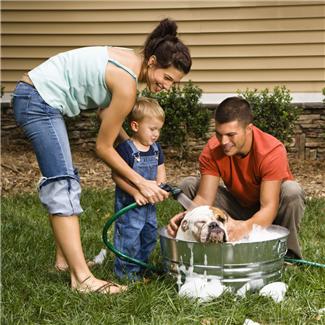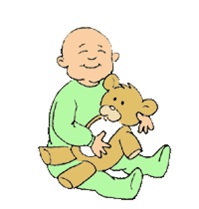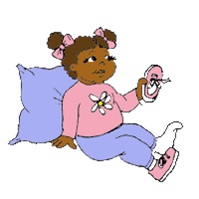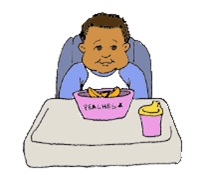During their first year, babies explore and learn about objects by mouthing, looking, and feeling.
- Around the first birthday, babies make an important discovery. They realize that things still exist even when they are not right there (This is called object permanence). A baby might search for his bottle under his blanket because he remembers there is a bottle!
- Once objects stay in memory like this, words become important tools. Everything has a name.
- One of the first questions that babies ask, with words, gestures, or facial expression, seems to be: "What's that?"
- Babies learn the names for things fast. Parents help babies by looking at what baby is looking at and using the name for it. This is called joint attention – you both tune in on the same thing.
Joint attention helps babies learn words.

|
Joint Attention- Here is a nice example of joint attention. The toddler and parents are all looking at and talking about the dog in the bath!
- When we give the name of something the child is already interested in and looking at, it helps the child make a connection from the thing to the word.
|
Get on the child's level.
- You want to be close to your baby and at eye level, so that both of you can attend to the object and listen to the word.
- If you are encouraging your baby to watch your face, then move your face close to the object before you speak.
Follow the child's lead.
- It is best to tune into your baby's attention.
- Babies easily become fascinated with whatever they are exploring.
- They typically do not want to stop at look at something the adult wants to talk about.
- Watch what holds your baby's interest and talk about those things and their actions.
- Follow the baby's lead and give words to match baby's interest.
Label, label, label, all day long.
- Name objects, but not just objects. Language is more than nouns.
- Name actions. Name feelings and reactions.
- Name simple concepts (e.g., how does it look, feel, taste, sound, move?).
- Name them all day long, in as many situations as you can find.
- Be sure your child's hearing aid or cochlear implant is working.
- Get on your child's level, if possible (e.g., join her on the floor; seat your baby close to you).
- Notice what your baby reaches for. If she reaches for toes, talk about toes. If she chews on a hat, talk about that!
- You can encourage your baby to listen to the word, and then look and listen in natural ways.
- Suppose you notice baby is hungry. You can say, "Listen, what's in daddy's bag?" (dad shakes the crackers). "Oh, I have crackers! (then bring them into baby and dad's line of vision). Crackers, see? You want a cracker? Yes, you are excited!"
- Everything has a name. Remind family members to name things that interest baby.
- It is easy for us to fall into a habit of using "it" (put it in). When baby is first learning words, use names instead (put the block in vs. put it in).
| If your baby depends on vision, then remember that you have to wait for the baby to look at the object first. Then, you can use some of the strategies that Deaf parents use to highlight the names of the objects.
- You can make the sign on the object itself. Your baby's eyes are already there, or they soon will be if you are signing there.
- You can produce the sign for the object your baby is looking at, as soon as the baby looks at you for information.
- You can make a sign right on the child (like the sign for "bath" on the little one's chest).
- You can point to something interesting, and, if your baby pays attention, name the object.
- You can move interesting objects into your baby's field of vision to attract attention.
- You can move so that your baby can see you easily.
-
www.handsandvoices.org/fl3/fl3-docs/maximize-visual-access-tips.pdf
|
Practice at Home:
Here are some practice examples. There are many things you could say...this gives a few ideas for getting started.
Teddy Bear
 | Baby wakes up and looks at the bear
| "There's Teddy Bear." |
Baby grabs bear.
| a. "Hug Teddy Bear."
b. "You love your bear."
|
Baby spills milk on the table.
| a. "Teddy Bear is wet." (sniff the bear)
b. "Your bear smells like milk!"
|
Shoes
 | Baby grabs own shoe.
| "There's your shoe!"
|
Baby struggles to get it off.
| "You want your shoe off? Pull!"
|
Shoe comes off.
| a. "You got your shoe off!"
b. "Do you want your other shoe off too?"
|
Peaches at lunch

| Baby takes a bite.
Possible responses: | a. "Mmmm. Peaches are good." b. "You like peaches." c. "You eat peaches. Yummy." |
Baby opens mouth for more.Possible responses:
| a. "More peaches." b. "Oh, another bite of peaches." c. "Here come the peaches. You want more." |